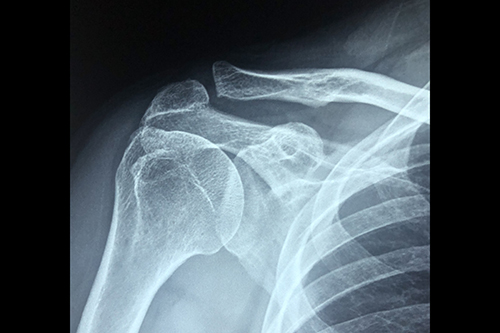New Prediction Model Aims to Inform Patients of Shoulder Replacement Surgery Risks
A new model to predict the risk of serious complications after shoulder replacement surgery has been developed in a collaboration between researchers from the Universities of Oxford, Bristol, and Copenhagen. The model, published in The Lancet Rheumatology today [31 July], could be an important tool to help both patients and doctors make more informed decisions about this common procedure.
Shoulder replacements are becoming increasingly common, with some countries seeing a 17-fold increase in surgeries over the past decade. However, serious adverse events including medical complications requiring admission to hospital can occur in over five per cent of patients.
Epaminondas Markos Valsamis, NIHR Doctoral Research Fellow at the University of Oxford and the paper’s lead author, explained: “Despite seeing a year-on-year rise of serious adverse events after shoulder replacement surgery, there is as yet no prediction model in widespread use to provide patients with personalised estimates of their expected risk.
“Patients, carers and clinicians have previously identified the importance of being able to make accurate predictions of patients outcomes to make well-informed decisions.”
Dr Adrian Sayers, Senior Research Fellow in the Bristol Medical School: Translational Health Sciences (THS) and a co-author, added: “The decision to undergo surgery is always difficult, and the ability of patients to weigh the risks and benefits of undergoing surgery is challenging. We hope this tool will be useful to patients and surgeons before they decide to undergo surgery.“
In collaboration with researchers from the universities of Bristol and Copenhagen, the Oxford team used data from the National Joint Registry (NJR) and NHS Hospital Episode Statistics in England to develop their risk prediction model. They analysed information from over 40,000 shoulder replacement patients, looking at factors such as age and medical conditions.
The research team then externally validated the model on patient data from 6,600 shoulder replacements in Denmark, demonstrating that it performs consistently well and can be applied broadly, beyond just the original English population.
Markos Valsamis said: “We found it was accurate and performed well both in England and Denmark and demonstrated that it has ‘clinical utility’, meaning it is beneficial to use in clinical practice.”
The resulting model was able to take inputs such as age, sex, and whether a patient has certain medical conditions, and accurately predict their risk of experiencing a serious adverse event, such as chest infections, heart attacks, and strokes, requiring hospitalisation within 90 days of their surgery.
Gillian Coward, NJR Patient Representative, explained: “Patients need to have realistic expectations about their surgery, and this model helps bridge gaps in their understanding.
“Armed with their personalised risk information, patients can work closely with their surgeon to decide on the best course of action for their individual circumstances.”
Jeppe Vejlgaard Rasmussen, shoulder and elbow surgeon at the University of Copenhagen, added: “As complications from shoulder replacement can significantly impact a patient’s quality of life and recovery, as well as being a major cost driver for healthcare systems globally, patients, clinicians and healthcare systems all stand to benefit from this type of predictive tool.”
Professor Jonathan Rees from the Oxford team and Head of the Nuffield Department of Orthopaedics, Rheumatology and Musculoskeletal Sciences, said: “The English and Danish research teams are working to make the prediction model widely available online through their national societies and partners.”

